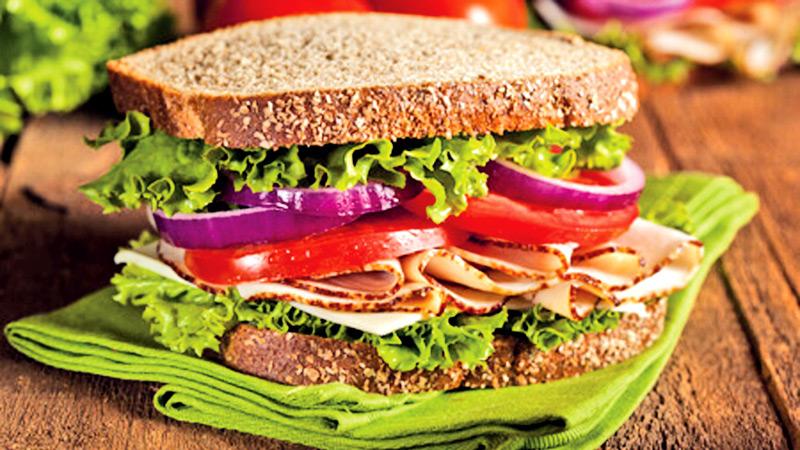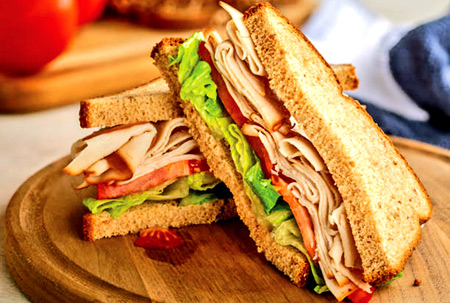
Sandwiches can be described as a delicacy enjoyed by everyone, regardless of their age. Many people who lead a busy life for a variety of reasons nowadays are more inclined to add a sandwich to their diet as a quick preparation. That is why many schoolchildren and those who go to work take a sandwich as their lunch. Although you may undoubtedly have tasted a sandwich, have you ever thought of its history?
 Sandwiches are one of the most popular types of food, taken to work, school, or picnics. The bread used to prepare sandwiches can either be plain or be coated with condiments, such as vegetables, cheese, meat and eggs with mayonnaise or mustard, to enhance its flavour and texture. Sandwiches are also widely sold in various retail outlets and can be served hot or cold. There are both savoury sandwiches, such as those stuffed with meat, and sweet sandwiches, such as peanut butter and jelly sandwiches.
Sandwiches are one of the most popular types of food, taken to work, school, or picnics. The bread used to prepare sandwiches can either be plain or be coated with condiments, such as vegetables, cheese, meat and eggs with mayonnaise or mustard, to enhance its flavour and texture. Sandwiches are also widely sold in various retail outlets and can be served hot or cold. There are both savoury sandwiches, such as those stuffed with meat, and sweet sandwiches, such as peanut butter and jelly sandwiches.
According to ancient sources, the ancient Jewish sage Hillel the Elder is said to have wrapped meat from the lamb and bitter herbs in a soft matzah—flat, unleavened bread—during Passover in the manner of a modern wrap made with flatbread. Flat breads of only slightly varying kinds have long been used to scoop or wrap small amounts of food throughout Western Asia and northern Africa. From Morocco to Ethiopia to India, bread is still baked in flat rounds, contrasting with the European loaf tradition.
Food-soaked trencher
 During the Middle Ages in Europe, thick slabs of coarse and usually stale bread, called “trenchers,” were used as plates. After a meal, the food-soaked trencher was fed to a dog or to beggars at the tables of the wealthy, and eaten by diners in more modest circumstances. The immediate culinary precursor with a direct connection to the English sandwich was to be found in the Netherlands of the seventeenth century, where the naturalist John Ray observed that in the pubs, beef hung from the rafters “which they cut into thin slices and eat with bread and butter laying the slices upon the butter”.
During the Middle Ages in Europe, thick slabs of coarse and usually stale bread, called “trenchers,” were used as plates. After a meal, the food-soaked trencher was fed to a dog or to beggars at the tables of the wealthy, and eaten by diners in more modest circumstances. The immediate culinary precursor with a direct connection to the English sandwich was to be found in the Netherlands of the seventeenth century, where the naturalist John Ray observed that in the pubs, beef hung from the rafters “which they cut into thin slices and eat with bread and butter laying the slices upon the butter”.
Initially perceived as food that men shared while gaming and drinking at night, the sandwich slowly began appearing in polite society as a late-night meal among the aristocracy. The sandwich is named after John Montagu, 4th Earl of Sandwich, an eighteenth-century English aristocrat. It is said that he has ordered one of his servants to bring him meat tucked between two pieces of bread. It is commonly said that Lord Sandwich was fond of this form of food because it allowed him to continue playing cards. The rumour in its familiar form appeared in ‘A Tour to London’ in 1772.
The sandwich’s popularity in Spain and the UK increased dramatically during the nineteenth century, when the rise of industrial society and the working classes made fast, portable, and inexpensive meals an essential part of their lifestyle. In London, for example, at least seventy street vendors were selling ham sandwiches by 1850; during that decade sandwich bars also became an important form of eating establishment in Western Holland, typically serving liver and salt beef sandwiches.
In the US, the sandwich was first promoted as an elaborate meal at supper. By the early 20th century, as bread became a staple of the American diet, the sandwich became the same kind of popular, quick meal as was already widespread in the Mediterranean.
Definition
In the 21st century, there has been considerable debate over the precise definition of sandwich; and specifically whether a hot dog or open sandwich can be categorised as such. In the United States, the Department of Agriculture and the Food and Drug Administration have accordingly come up with the definition, “at least 35 percent cooked meat and no more than 50 percent bread” for closed sandwiches, and “at least 50 percent cooked meat” for open sandwiches.
In the United Kingdom, the British Sandwich Association defines a sandwich as “any form of bread with a filling, generally assembled cold”, a definition which includes wraps and bagels, but excludes dishes assembled and served hot, such as burgers.
In the US, a court in Boston, Massachusetts, ruled in 2006 that a sandwich should include at least two slices of bread and “under this definition, this court finds that the term ‘sandwich’ is not commonly understood to include burritos, tacos, and quesadillas, which are typically made with a single tortilla and stuffed with a choice filling of meat, rice, and beans.”
In the UK and Australia, the term sandwich is more narrowly defined than in the US: it usually refers to an item which uses sliced bread from a loaf. An item with similar fillings, but using an entire bread roll cut horizontally in half, is generally referred to as a roll, or with certain hot fillings, a burger. However, hot sliced (not ground) beef between two slices of toasted bread is referred to as a steak sandwich: it is the sliced loaf bread that distinguishes the steak sandwich from a burger.
